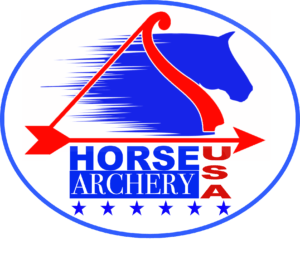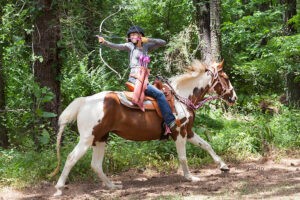 Archery from horseback has been used for warfare, community protection, and hunting for centuries. More recently, horse archery has been enjoyed as a sport or recreation in many countries worldwide.
Archery from horseback has been used for warfare, community protection, and hunting for centuries. More recently, horse archery has been enjoyed as a sport or recreation in many countries worldwide.
Many enthusiasts come to horse archery on their own, either after a film or tv show, or simply seeking to combine two sports they love. At some point many want to share the experience with others. In the United States, HAUSA is one of the ways horse archers come together.
With trial and error and some historical research, the horse archery community has discovered a few ways to maximize enjoyment of the art.
Archery Equipment
Horse archery is performed at speed and at short distance. There isn’t much need to shoot far when you’re moving past your target at the gallop. Equipment designed for horse archery is designed to maximize agility and speed and minimize risk.
Horse bows are light and small- generally 20-40# draw and under 50 inches, depending on the size and 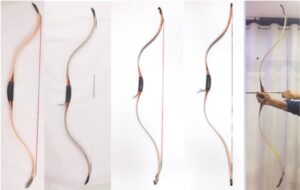 strength of the rider. A shorter bow is easier to maneuver without touching your horse. Horse bows are often recurve, to maximize power for a small size, and they have no shelf or arrow rest. If a horse archer uses a knock point on the string, they use only one. Knocking is done by feel and in motion. Simplicity is best.
strength of the rider. A shorter bow is easier to maneuver without touching your horse. Horse bows are often recurve, to maximize power for a small size, and they have no shelf or arrow rest. If a horse archer uses a knock point on the string, they use only one. Knocking is done by feel and in motion. Simplicity is best.
Arrows are usually carbon or bamboo and have 2-4 feather flights. Remember knocking by feel (sometimes called blind knocking)? A horse archer does not align the fletching away from the bow as a ground archer might. Some courses might require rubber blunt arrows or flu flu arrows for safety.
There are many quiver designs in use for horse archery. An archer’s favored draw style will affect which quiver suits best.
A common back quiver may be used. Some designs are shaped to reduce movement of the arrows and there are several strap or harness designs to choose from for security. Canyon Cappola of Nomad Warriors has designed a quiver that sits laterally across the lower back. Many horse archers use a hip or thigh quiver, designed to sit along the draw-side thigh. These often have slots for arrows to be set in singly. There are also what are called sword quivers, for the fact they allow the arrows to be drawn across the body as a sword would be. These sit at the waist on the bow hand side.
Bow cases or quivers can be used to hang the bow from the saddle when not in use.
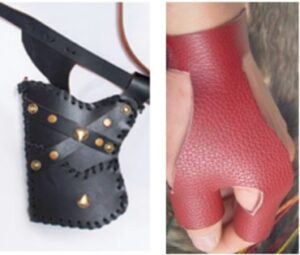 Many horse archers choose to use a partial bow glove on the bow hand to protect from fletchings. Also, some archers use a glove or thumb ring to protect the draw hand. If you wear riding gloves, these would substitute for both. Thinner gloves will make handling of bow and arrows easier.
Many horse archers choose to use a partial bow glove on the bow hand to protect from fletchings. Also, some archers use a glove or thumb ring to protect the draw hand. If you wear riding gloves, these would substitute for both. Thinner gloves will make handling of bow and arrows easier.
Archery Draws
Most archers learn the three finger, also known as the Mediterranean draw. Although created for long distance ground archery, many horse archers still choose to use it. We encourage you to consider trying one of the draw methods designed for horseback archery.
The thumb draw is a method where the hand is held in a loose fist and the string is pulled by the crook of the folded thumb.
The Persian draw still uses three fingers, but those fingers are angled across the string with the index finger on the arrow.
Some excellent early exercises for a new horse archer are practicing drawing and nocking the arrow without looking and practicing the various draws on the ground.
Tack
Horse archery can be performed in any style of tack. The most important part is safety. Riders often choose the same tack they ride in for other sports for the sense of familiarity. It is wise to have some way to control the reins when not in hand. Riders in western saddle may use the horn, in English might use a clip or bungee to a grab strap or D ring.
The Horse
Any kind of horse can participate in horse archery, and in fact many enjoy it. When training a horse to archery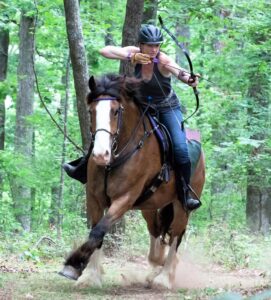 focus on both steadiness of character and self carriage. The horse will be asked to perform with many distractions and without rein contact. Take time to desensitize the horse to rider movement and sound coming from the saddle and the target. Practice carrying something while riding. Practice shooting with someone safely holding the horse nearby. Practice riding by someone shooting on the ground. Also, when riding, test your horse’s ability to maintain rhythm, direction, and balance without rein cues. In HAUSA, we have a unique program where riders are tested on their ability to guide their horse through patterns while firing at targets.
focus on both steadiness of character and self carriage. The horse will be asked to perform with many distractions and without rein contact. Take time to desensitize the horse to rider movement and sound coming from the saddle and the target. Practice carrying something while riding. Practice shooting with someone safely holding the horse nearby. Practice riding by someone shooting on the ground. Also, when riding, test your horse’s ability to maintain rhythm, direction, and balance without rein cues. In HAUSA, we have a unique program where riders are tested on their ability to guide their horse through patterns while firing at targets.
Courses
Once you and your horse are both comfortable with the bow and arrows, then it’s time to decide what you’re going to do with your new skills. You can look for nearby activities here.
There are many styles of competition and courses. Some are performed on a track with various targets to test speed and precision. Some are done in an arena and field with a pattern for speed, inspired by gymkhana or barrel racing. Some are even set up in a cross country course fashion, riding through woods and fields. In HAUSA, we also have the technical test, called Reining Arrows when held in a postal match. You can learn more about individual courses here.
